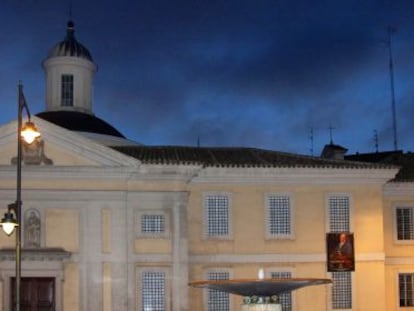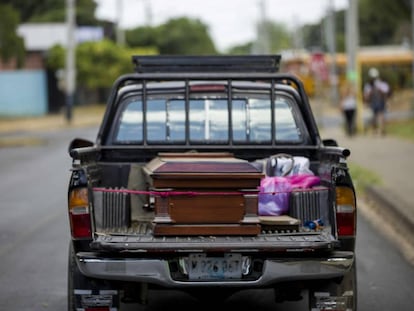From levitations to evil mothers-in-law: The busy life of an exorcist in 2023
‘The Pope’s Exorcist,’ starring Russell Crowe, tells the story of the famous priest Gabriele Amorth and his sometimes controversial battles against the devil
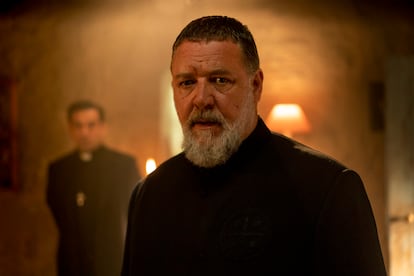

If you want to be an exorcist, you must be willing to be spat on continuously. That is one of the most memorable observations shared by Father Gabriele Amorth (Modena, 1925 - Rome, 2016) in one of the many books he wrote, Father Amorth: My Battle Against Satan, where he summarized, in an interview with journalist Marco Tosatti, everything he learned after the 70,000 victims of possession he claimed to have liberated up to that moment. Officially recognized as an exorcist by the Vatican in 1986, Amorth was the best-known figure of the trade due to his strong presence and his public controversies (among other things, he warned the world that communism, yoga and the Harry Potter saga opened the doors to the evil one). His experiences and writings also served as the basis for the film The Pope’s Exorcist, which will be released on April 5, with Russell Crowe in the role of the Italian priest.
His incorporation into horror cinema was only a matter of time: shortly before his death at the age of 91, he starred in the documentary The Devil and Father Amorth (2017), made by William Friedkin, the director of The Exorcist (1973), his favorite movie. In that posthumously released title, the Vatican allowed Friedkin to witness and record a real exorcism performed by Amorth — although the material was not as dramatic as that of the horror classic, nor did it contain anything paranormal beyond a woman who screams with a distorted voice.
Meanwhile, the trailer for The Pope’s Exorcist makes it clear that the new film will have plenty of spitting, as well as flying objects, vomit spiked with nails or dead animals, levitating bodies and phrases spoken in occult or dead tongues, all elements associated with these rituals (thanks, in part, to the writings of Amorth), along with one of the priest’s most famous quotes, one that seems to have been written to be uttered by Crowe: “I’m not afraid of the devil. The devil is afraid of me.”
“Russell Crowe doesn’t convince me, I feel like I’m seeing a gladiator in a cassock,” Argentinean exorcist Manuel Acuña, founder of the School of Exorcists of Europe, based in Spain, says sarcastically over the phone. Acuña was a friend of Gabriele Amorth; he boasts about appearing in the only selfie ever taken with the Italian priest. “He was a teacher to me, a fascinating man and the greatest in the ministry of exorcisms,” he recalls. “We’ll have to see the film to find out what’s in it, but I don’t think anyone who knew Father Amorth will see him as he appears in the trailer, or that his figure will be treated faithfully. He rejected showiness, he was very humble. The fact that his mystical life and his trust in the Blessed Virgin are being used is not appreciated.”
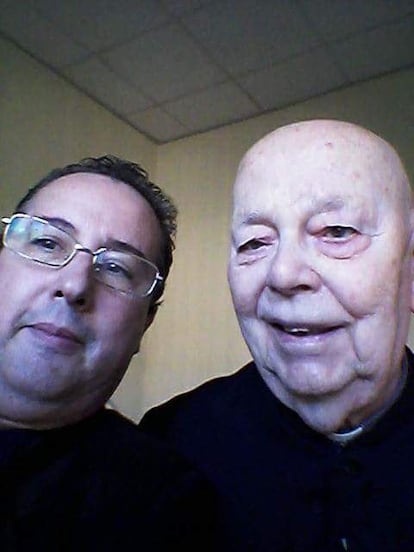
The demonologist, who has given lectures at the Regina Apostolorum Pontifical Athenaeum in Rome, is not particularly fond of the film subgenre, considering it “folkloric and not very rigorous.” Apart from The Exorcist, which he does consider an accurate representation of what it means to face “powerful principalities of hell,” he only likes two more films: The Exorcism of Emily Rose (2005) and The Rite (2011) — despite their “cinematic and fanciful” elements. However, in the more than 1,200 exorcisms that he claims to have performed in his 18-year career (the first was at the age of 42; he is now 60), he has “seen it all,” he says. “Except for a head turning 360 degrees — that’s impossible!”
“You may believe me or not, but I have seen a six-year-old boy levitate 10 centimeters [four inches] above the ground and stay there for five minutes, violating all the laws of nature. In my first exorcism, I saw a 42-kilo [92.5-pound] teenager push big men aside as if they were made of paper. That is known as Samsonism. He was possessed by three spirits. When I was done, I went outside to cool down and got in my car. With the key still in my hand, the doors shut closed, the lights came on, including the interior light, and the horn began to sound. That day I knew that I had just exchanged business cards with the devil.”
From madness to possession
The Exorcism of Emily Rose, one of the films mentioned by Acuña, is inspired by the true story of Anneliese Michel, a young German woman with a long psychiatric history. After her death at the age of 23, in 1976, her parents and the two priests who had performed 67 exorcisms on her were convicted of negligent homicide, due to severe malnutrition and dehydration (she weighed only 66 pounds), two broken knees from the numerous genuflections and a case of pneumonia. Michel claimed to be under the possession of different demons, including Adolf Hitler. In 2014, the Archbishopric of Burgos admitted to having authorized exorcisms on a minor with a history of anxiety, anorexia and suicide attempts, who would end up taking her own life in 2019, when she was 22. Her story was also included in a film: the Spanish 13 exorcismos (or, 13 Exorcisms, 2022).
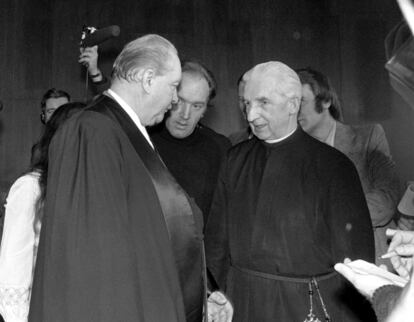
Father Acuña denies that the ritual involves “any physical violence or torture whatsoever.” He refers to The Exorcist again: “At what point do Father Karras and Father Merrin do something violent to the girl? They say these things to make us look bad. The only instruments are the sacramental elements: holy water, anointing oil and, of course, the common prayer of the group that accompanies the exorcist. Never anything to attack the person,” says the priest, who assures that he surrounds himself with “doctors, psychologists and psychiatrists” in his work, although he believes that mental health professionals “are not trained to identify the phenomena of possession,” which are, he lists, “Samsonism, levitation, xenoglossy [speaking in strange languages], knowledge of the occult, clairvoyance and hierophobia [fear of sacred things].”
In Father Amorth: My Battle Against Satan, Father Gabriele Amorth does admit to having tied up supposed victims of possession; they are so strong, he argued, that they cannot be held down. Amorth was prominently opposed to the 1999 revision of the Rituale Romanum, carried out during the papacy of John Paul II and intended to limit the criteria when applying exorcisms (that dispute was settled with the inclusion of a note in the prologue stating that the update was optional). Acuña laments how rationalism has gained a place in the Church. “There are bishops who make psychiatric and psychological referrals because they don’t believe in the devil. But the devil is not imaginary, nor a concept, nor an idea. He is a personality and has a strategy, of which possession is a part. The devil doesn’t pretend to be the devil; the devil is!” he declares.
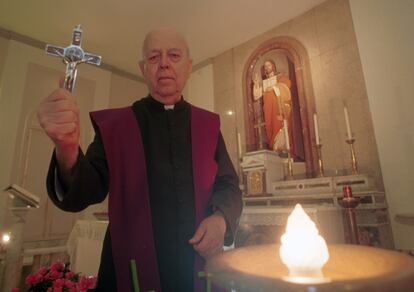
“The contribution of Pope Francis has been, in this sense, very positive. He is the one who has spoken the most about the existence of the devil to the media,” says Acuña. In 2014, Pope Francis recognized the International Association of Exorcists, founded by Amorth two decades earlier. He has publicly recommended the practice and, in 2013, a video was revealed in which specialists identified the pontiff performing an exorcism on a man during a prayer — although the Vatican denied it. His endorsement of the ritual seems to be in tune with the times: an article published in Le Monde in 2014 reported that the demand for exorcisms had skyrocketed; the Italian Association of Catholic Psychologists and Psychiatrists has stated that half a million Italians request an intervention of this type every year; and in the United States they have grown tenfold, the same proportion as the members of the Association of Exorcists — from 25 to 250 (they say that there are approximately 800 worldwide, most of them in Italy). During the Covid-19 pandemic lockdown, the Church saw another rise in alleged possessions.
Deliver us from the evil one
In his memoirs, Father Amorth explains the many ways a person can end up under the control of either the devil or a dead person. In some nightclubs, he says, there is a fixed agenda: a boy or a girl goes there and they start with tobacco. Then they move on to drugs, then to sex and then to a satanic sect. In one chapter, he describes the case of “a pranotherapist” who admired Elvis Presley to the point of idolatry and was able to attract a spirit that had been “inside the singer.” In another, he tells the story of an “occultist mother-in-law” who placed a curse on her daughter’s marriage that, according to the son-in-law, resulted in a run of bad luck and in the couple’s bed moving (spiteful ladies who resort to necromancy against their sons-in-law are a frequent occurrence, Amorth points out in the book).
In 2016, Italian filmmaker Federica di Giacomo offered a demystifying and costumbrist look at exorcisms through the documentary Liberami (or, Deliver Us), which follows the story of a provincial priest, Father Cataldo, in his fight against the devil. Cataldo is portrayed almost as a sort of gray bureaucrat who is used to dealing, crucifix in hand, day in and day out, with people rolling around his parish’s floor, yelling atrocities at him and reacting hysterically to his prayers. In one of the funniest moments of the film (which, just like Friedkin’s documentary on Father Amorth, shows no paranormal phenomena of any kind), Cataldo discusses with one of his collaborators the problem of exorcising an elderly lady who, due to her loneliness, “lives better” being possessed, because then she is the center of attention. In another, some parents require Cataldo’s services because their son does not want to go to school, which they see as an unequivocal sign that he is in the clutches of the devil.

One of the most surprising parts is the extraordinarily anticlimactic scene where the priest dispatches an exorcism by phone, while a voice is heard shouting something indistinct on the other end of the line. “You can do the procedure by phone. Father Amorth did some,” confirms Acuña, who cites as precedents the miracles of the healing of the daughter of the Syrophoenician woman and the healing of the centurion’s servant, both carried out remotely by Jesus Christ, according to the Scriptures. The priest also explains that “the Our Father contains an exorcism: ‘Deliver us from the evil one.’ The original does not say ‘evil,’ it says ‘the evil one.’ Therefore, all Christians who believe in the devil can do an exorcism by saying the Our Father prayer.”
Sign up for our weekly newsletter to get more English-language news coverage from EL PAÍS USA Edition
Tu suscripción se está usando en otro dispositivo
¿Quieres añadir otro usuario a tu suscripción?
Si continúas leyendo en este dispositivo, no se podrá leer en el otro.
FlechaTu suscripción se está usando en otro dispositivo y solo puedes acceder a EL PAÍS desde un dispositivo a la vez.
Si quieres compartir tu cuenta, cambia tu suscripción a la modalidad Premium, así podrás añadir otro usuario. Cada uno accederá con su propia cuenta de email, lo que os permitirá personalizar vuestra experiencia en EL PAÍS.
¿Tienes una suscripción de empresa? Accede aquí para contratar más cuentas.
En el caso de no saber quién está usando tu cuenta, te recomendamos cambiar tu contraseña aquí.
Si decides continuar compartiendo tu cuenta, este mensaje se mostrará en tu dispositivo y en el de la otra persona que está usando tu cuenta de forma indefinida, afectando a tu experiencia de lectura. Puedes consultar aquí los términos y condiciones de la suscripción digital.
More information
Archived In
Últimas noticias
There is as much life left to discover on planet Earth as that which is already known
Dozens presumed dead, around 100 injured in fire at Swiss Alps bar during New Year’s celebration
Is porn for women different from conventional porn? We spoke to those who make it
Cartagena de Indias is sinking: What can the city do to mitigate it?
Most viewed
- Reinhard Genzel, Nobel laureate in physics: ‘One-minute videos will never give you the truth’
- David King, chemist: ‘There are scientists studying how to cool the planet; nobody should stop these experiments from happening’
- Oona Chaplin: ‘I told James Cameron that I was living in a treehouse and starting a permaculture project with a friend’
- Sinaloa Cartel war is taking its toll on Los Chapitos
- The Interoceanic Train, the Mexican alternative to the Panama Canal
